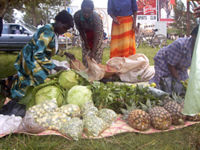Treatment Literacy/Information needs/HIV
| HIV Treatment Literacy | ||
|---|---|---|
| Learn the science of HIV and the various treatment options | ||
| Introduction | What is treatment literacy? | Effects of lack of treatment literacy | Community Empowerment |  |
| Information needs | Counseling, testing & treatment awareness | Prevention & Treatment | Anti-retroviral drugs | Adherence | HIV Nutrition & Health | Stigma, discrimination & human rights | |
| Resources | Conferences | Teaching materials | Relevant Websites | |
| Work in progress, expect frequent changes. Help and feedback is welcome. See discussion page. |
Contents
1. Opportunistic infections and diseases
Partial list of the world's most common HIV-related opportunistic infections and diseases :
- Bacterial diseases such as tuberculosis, MAC, bacterial pneumonia and septicaemia (blood poisoning)
- Protozoal diseases such as toxoplasmosis, microsporidiosis, cryptosporidiosis, isopsoriasis and leishmaniasis Fungal diseases such as PCP, candidiasis, cryptococcosis and penicilliosis
- Viral diseases such as those caused by cytomegalovirus, herpes simplex and herpes zoster virus
- HIV-associated malignancies such as Kaposi's sarcoma, lymphoma and squamous cell carcinoma.
Different conditions occur at different stages of HIV infection: In early HIV disease people can develop tuberculosis, malaria, bacterial pneumonia, herpes zoster, staphylococcal skin infections and septicaemia. These are diseases that people with normal immune systems can also get, but with HIV they occur at a much higher rate. It also takes longer for a person with HIV to recover than it takes for someone with a healthy immune system. When the immune system is very weak due to advanced HIV disease or AIDS, opportunistic infections such as PCP, toxoplasmosis and cryptococcosis develop. Some infections can spread to a number of different organs, which is known as 'disseminated' or 'systemic' disease. Many of the opportunistic infections that occur at this late stage can be fatal.
Highly Active Antiretroviral Therapy (HAART) can reduce the amount of HIV in someone's body and restore their immune system. The introduction of HAART has dramatically reduced the incidence of opportunistic infections among HIV-positive people who have received the drugs.
Yet the prevention and treatment of opportunistic infections remains essential.
| A Guide to Treating Opportunistic Infections for People with HIV/AIDS Issued by TAC, July 2001 It is a large file, downloadable page per page here Immune Reconstitution Syndrome (IRS) |
2. Nutrition & Health
"Eating right helps the body resist sickness":
- Nutrition counseling and support is an essential component of care for the HIV-infected person and it is particularly important in resource-constrained settings where malnutrition and food insecurity are endemic,
- The AIDS Equation :
AIDS has a devastating effect on a person's nutritional wellbeing: nutrient absorption is reduced; appetite and metabolism are disrupted; muscles, organs and other tissues waste away; secondary infections and other stresses increase demand for energy and nutrients. Despite appetites loss and difficulties in eating, people living with HIV/AIDS should eat considerably more food to fight the illness and make up for weight loss.
|
As part of a balanced diet someone affected by HIV/AIDS needs :
|
- Side effects of HIV treatments and how they can be managed:
All medicines, including ARVs can have side effects. ARV side effects can be mild or serious but most can be managed. ARV side effects can include anemia, nausea, skin rash, liver problems or num/painful feet (called Peripheral Neuropathy) depending which combination is taken. Side effects of all medicines, including herbal and traditional medicines, must be reported immediately. Understanding possible side effects before starting treatment avoids misinformation and fear about ARV’s.
